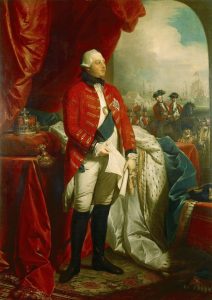About the Omohundro Institute of Early American History & Culture

Benjamin West, George III, 1779
Royal Collection Trust / © Her Majesty Queen Elizabeth II 2017
The Omohundro Institute of Early American History & Culture supports scholars and scholarship focused on the expansive field of early American history. The OI has produced a deep bench of award-winning scholarly monographs, published the leading journal in the field, the William and Mary Quarterly, and sponsored events including conferences designed to bring together scholars for robust exchange. The OI also offers a range of fellowship programs and a rigorous training program for editorial apprentices. The OI’s rich history can be explored through its archive of publications, programs, and fellowship recipients.
Housed on the campus of its primary sponsor William & Mary in Williamsburg, Virginia, the Institute of Early American History & Culture is an independent research organization established in 1943. The name of benefactors Mr. and Mrs. Malvern H. Omohundro, Jr., was added in 1996 in recognition of their generous support of the OI.
Our Role
With initial support from the Lapidus Initiative, the OI’s month-long Georgian Papers fellowships support research on transatlantic and early American topics. Fellows explore the collections of the Royal Archives at Windsor Castle for their own research, while offering invaluable information for the team of archivists and librarians working on archival organisation and cataloguing. The OI will sponsor up to eight OI-GPP fellows annually throughout the duration of the project. In addition to the fellowships, the OI, in collaboration with its UK partners, will play a lead role in organising workshops and conferences in both countries. Workshops will draw together all of the scholars who have worked in the Royal Archives under the auspices of the GPP fellowships. These will take place annually at Windsor. In addition to these fellowships and workshops, conferences will allow for scholarly exchange on subjects of historical significance related to the GPP; the GPP provides an opportunity both for fresh research from the materials themselves but also for renewed attention to the period.
